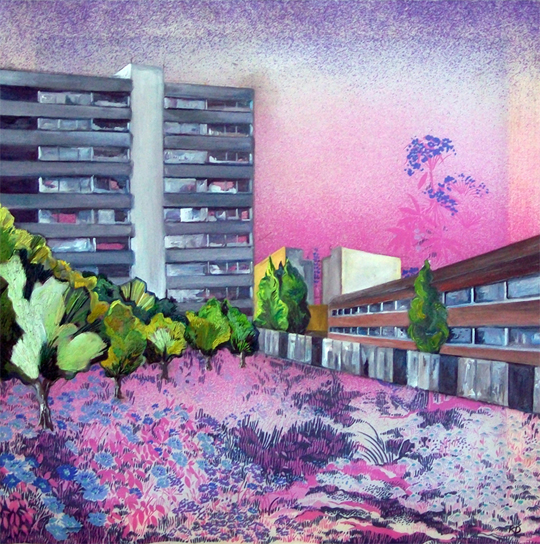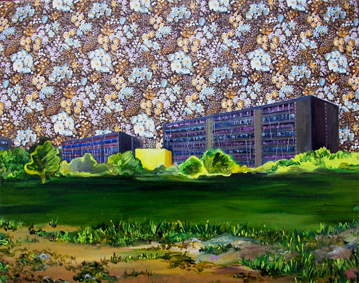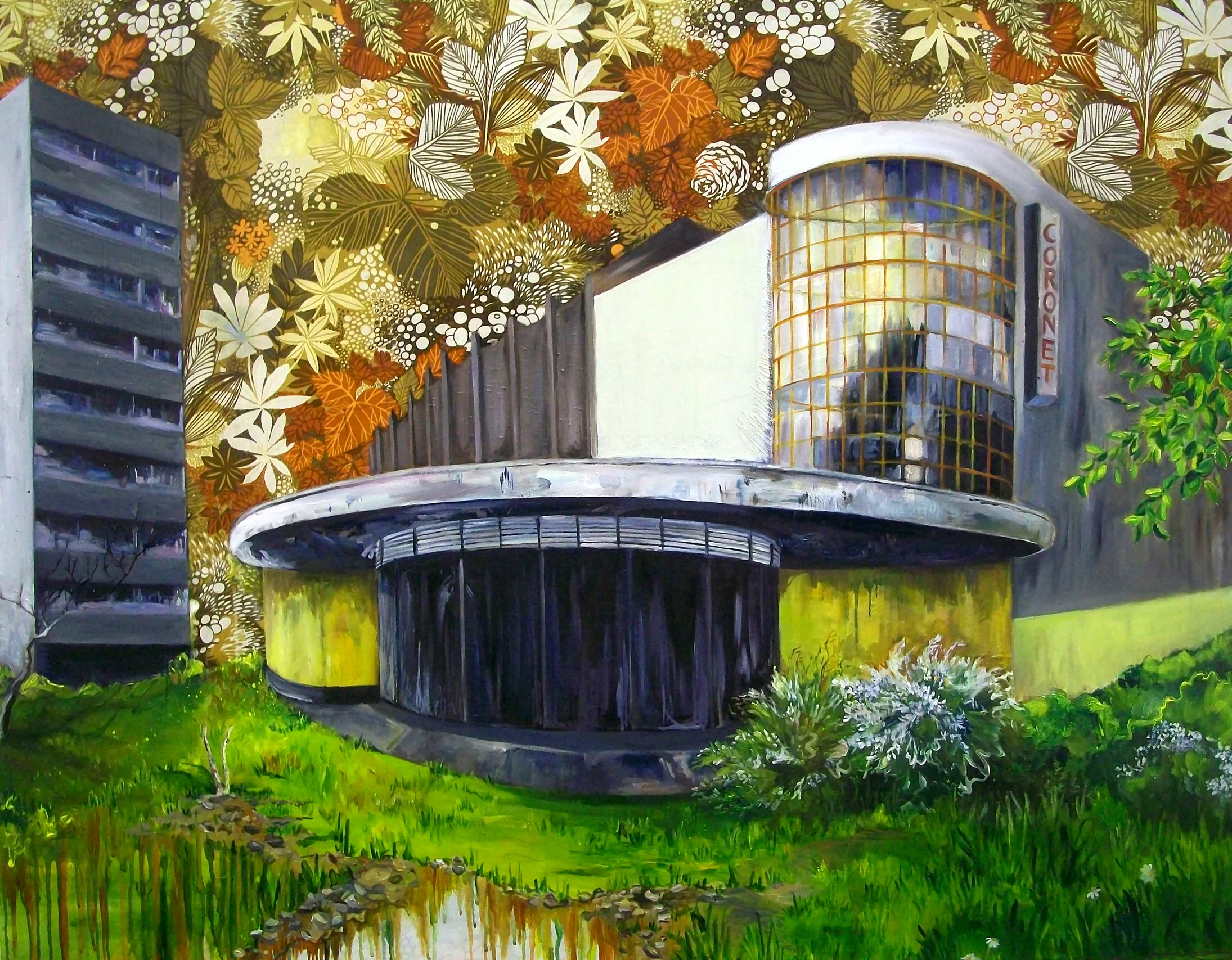Is surface texture, pattern and ’the natural’ an escape or a trap? Rosalind Davis talks to Andrew Bryant about this and other questions in her work.
Andrew Byant: You went to study textiles at the RCA but spent most of your time in the painting dept. Could you speak about that transition, what painting means to you and how it perhaps enables certain things to happen that textiles didn't?
Rosalind Davis: I come from an artistic background, my father Peter Davis is an artist and we spent our childhood absorbing a lot of art. I also had a fantastic art education at Sydenham School which had a revolutionary approach at that time, I worked in oils from the age of 13 (a rarity in state schools) and my teacher got funding so I could go to Nice and Barcelona to study the art there - it meant I had a relatively good grasp on the medium of paint from a young age. I was always painting. During my BA at Chelsea I worked closely with painting and photography to create innovative surfaces, manipulating latex and monofilament. Within my work now I still manipulate and transform materials and surfaces.
At the RCA I didn't actually have the opportunity to be in the painting department but I did snaffle the painting professor Graham Crowley. Graham stripped me of my fears of calling myself an artist and the realities of art as a profession. He delighted in the mixtures of my mediums and pushed me as a painter. He has continued to be a fantastic mentor to me and Core Gallery. The artists George Bolster and Paul Benjamins were also mentors to me and I have now accumulated many artistic networks which is very fruitful for my progression.
One of the differences in studying Textiles at the RCA was that my peer network wasn't made up of artists and so I did not get to meet many lecturers and curators with whom I could develop working relationships or peer networks with after the RCA. I came out of RCA and had to graft that myself in the subsequent years (hence wanting to help other artists with our DIY Programme at Core Gallery).
Painting means a huge amount to me, as I spoke about in one of my Artists talking blogs. Painting is something I feel I will never conquer, I love its mellifluous qualities, its challenges and ability to transform a surface. Mind you I feel equally strongly about textiles and the range of expression I can get from that. Both are enabling to me and fused together, they create something quite unique.
I was very aware about the politics and hierarchical nature of paint and textiles, but feel that a lot of those hierarchies have been broken down in fine art with the evolution of mediums and the way artists use them. I also chose to no longer care about the hierarchy of mediums, I chose that which is the best way to express my concepts.
AB: Your painting represents a paradox where the forces of decay seem also to be a way out of the failure of modernity, as if the escape - into the abstractions of surface texture, pattern and also into 'nature' - is simultaneously a trap, a place where we might literally lose ourselves or come undone.
RD: My painting explores many paradoxes as I seek to transform the failing of modernity. My work is an examination, a documentation of the ideals of utopia and dystopia, of human experience and a reflection on the socio-political aspects of these urban developments and disintegration. I find it an interesting and tragic paradox that so many of these high rise buildings were inspired by a belief that people would be closer to God, yet 40 or 50 years later these places are described as ' Hell's living room'
In many ways I see my paintings as a homage to or celebration of the survival of the many people, usually from low socio economic backgrounds, who lived and loved within these spaces, despite clearly difficult living circumstances and often abject poverty. Communities and support systems are created and shared in the face of division. Human endeavour is commemorated despite the decay and dystopia. Through creating a tension between embellishments and depiction, sensuality and awkwardness within my paintings, people are drawn in by the intimacy of the surface and look more closely at the artworks and the subjects within them.
Through creating a visionary landscape people can adjust or explore their own thoughts about what these spaces mean to others and to themselves. The compulsion that society and the individual have to sometimes self destruct, yet reinvent, is a constant. Sometimes through this destruction we can come to a better understanding of ourselves. To push ourselves: to survive and develop. I feel I need to celebrate that somehow.
AB: Can you talk about how your ideas evolve, where they are at now and where you think they might be going?
RD: I feel I always need to push my work conceptually, physically and aesthetically through experimentation.
Last autumn I felt safe and I needed to progress and break open my practice again, to fall into an abyss of experimentation so as to push my work forward. It meant not thinking of making work for exhibitions in the usual vein and to allow myself time to develop and for things to go wrong. I have separated the textiles from the paint, creating dual pieces that became completely immersed in each of the separate mediums. I needed to mirror the meticulousness of my embroidery in my painting (which had become almost obsolete from my work at that time). It meant I had to make myself paint in new and different ways and the textiles I created informed me of how to do that in paint. It's a wonderfully symbiotic way of working which I am enjoying very much. I feel the work is developing in an exciting way
My ideas for artworks evolve in a number of different ways. Before I begin the painting I research the history and politics of a space/ environment or building: bad planning; poverty leading to ghettoisation for example, but also look at government policies and redevelopment schemes that have unwittingly and irresponsibly entrapped people in bad situations like Kidbrooke and The Heygate. I read articles and blogs and also have at times interviewed people.
I source buildings through research, sometimes physically - cycling through an area and taking photos. Sometimes I am informed by other people's photos or information about the spaces they inhabit. Exhibitions also inspire me. Sometimes a piece of fabric inspires me, for example a Toile De Jouy fabric led me to ask questions about industrialisation, the current economic crisis and the exportation and outsourcing of so many industries within the UK.
Recently the work I have been doing has been focussed on an exhibition I am curating and exhibiting in October at Core Gallery with Annabel Tilley. The show is called 'Home', which is a very loaded word (fragile, transient, extraordinary...). In contrast I am also interested in examining the various climatic disasters that have occurred in the last few years such as hurricane Katrina and its devastating effect upon the whole of a society and place.
Rosalind Davis is a painter who uses textiles. She graduated in 2005 from the Royal College of Art in London and now manages a gallery in South East London called Core Gallery.


